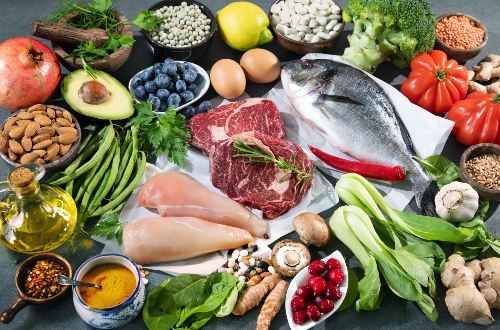Ever get confused with what you are supposed to be eating and drinking? The 2020-2025 Dietary Guidelines for Americans (DGA) can help with that! [1]
These guidelines are updated every 5 years. The purpose of the guidelines is to make recommendations for good health and to prevent disease. Everyone can benefit from making small changes in food and drink choices to have a healthier dietary pattern.
The current guidelines are different from the previous dietary guidelines in the following ways:
- The guidelines are more helpful for people with different cultures and budgets.
- Plant-based diets are encouraged.
- Recommendations are given for each stage of life, including infants and children.
- Encourages overall dietary patterns more than individual food or nutrients.

4 Key Guidelines:
1. Follow a healthy dietary pattern at every age. It is never too early or too late to eat healthy.
- Birth to 6 months: feed infant’s only human milk. If human milk is not available, give infant formula with iron during the first year of life. Ask your doctor about additional vitamin D soon after birth.
- 6 months: Start introducing foods along with the breast milk/formula. Give foods that contain iron and zinc, such as pureed meats, pureed/mashed beans and lentils and pureed greens.
- 12 months through older adults: follow a healthy diet to help reach a healthy weight and lower chance of disease.
2. There is no one right way to eat. Choose nutrient dense foods and drinks that meet your cultural traditions, personal likes and dislikes, and budget. Enjoy your food! Visit our Personalize Your Plate blog for ideas on how to customize your meals.
3. Focus on meeting food groups needs with nutrient dense foods and beverages. Stay within calorie limits. (See our blog on Food Talk Features to learn more about the different food groups.)
- Vegetables of all types
- Fruit
- Grains
- Dairy
- Protein Foods
- Dairy
4. Limit foods and drinks high in added sugars, saturated fats, and sodium. Limit alcoholic beverages.
- Limit added sugars – less than 10% of calories per day for ages 2 and older (avoid added sugars for infants and toddlers).
- Limit saturated fats – less than 10% of calories per day starting at age 2.
- Limit sodium – less than 2,300mg per day (or even less if younger than 14).
- Limit alcoholic beverages (if consumed). When adults of legal drinking age choose to consume alcohol, limit to 1 drink or less in a day for women, 2 drinks or less a day for men. (Drinking less alcohol is better for health than drinking more. Some adults should not drink alcohol, such as women who are pregnant.)

Ways to Use the Guidelines:
- MyPlate- can be used to build a healthy, balanced plate that can be individualized to meet your needs. See MyPlate.gov for more information. [2]
- MyPlate Plan- visit MyPlate.gov/myplate-plan to discover your food group targets. Learn what and how much to eat within your calorie allowance. You can also download a MyPlate cell phone app, which allows you to pick daily goals, see real-time progress and earn fun badges. [3]
- MyPlate Quiz- visit Myplate.gov/myplate-quiz to take a 5-minute quiz about your current eating habits and get personalized results. [4]
- Nutrition label- see our Food Label Facts blog to learn more about reading a food label in order to make healthy food choices.
Make Every Bite Count:
- Use foods and beverages to meet nutrition needs.
- Choose a variety of options from each food group.
- Make nutritious choices one meal at a time.
- Follow a healthy eating pattern at every life stage.
- Pay attention to portion size
To learn more healthy recipes, tips on cooking, exercise and other nutrition information click on Foodtalk.org.
Written by Leslie C. Davis, MS, RDN, LD, CDCES | edited by the Nutrition Education Team
Posted March 31, 2021
[1]. Dietary Guidelines for Americans- dietaryguidelines.gov
[2]. MyPlate- myplate.gov
[3]. MyPlate Plan- myplate.gov/myplate-plan
[4]. MyPlate Quiz- myplate.gov/myplate-quiz